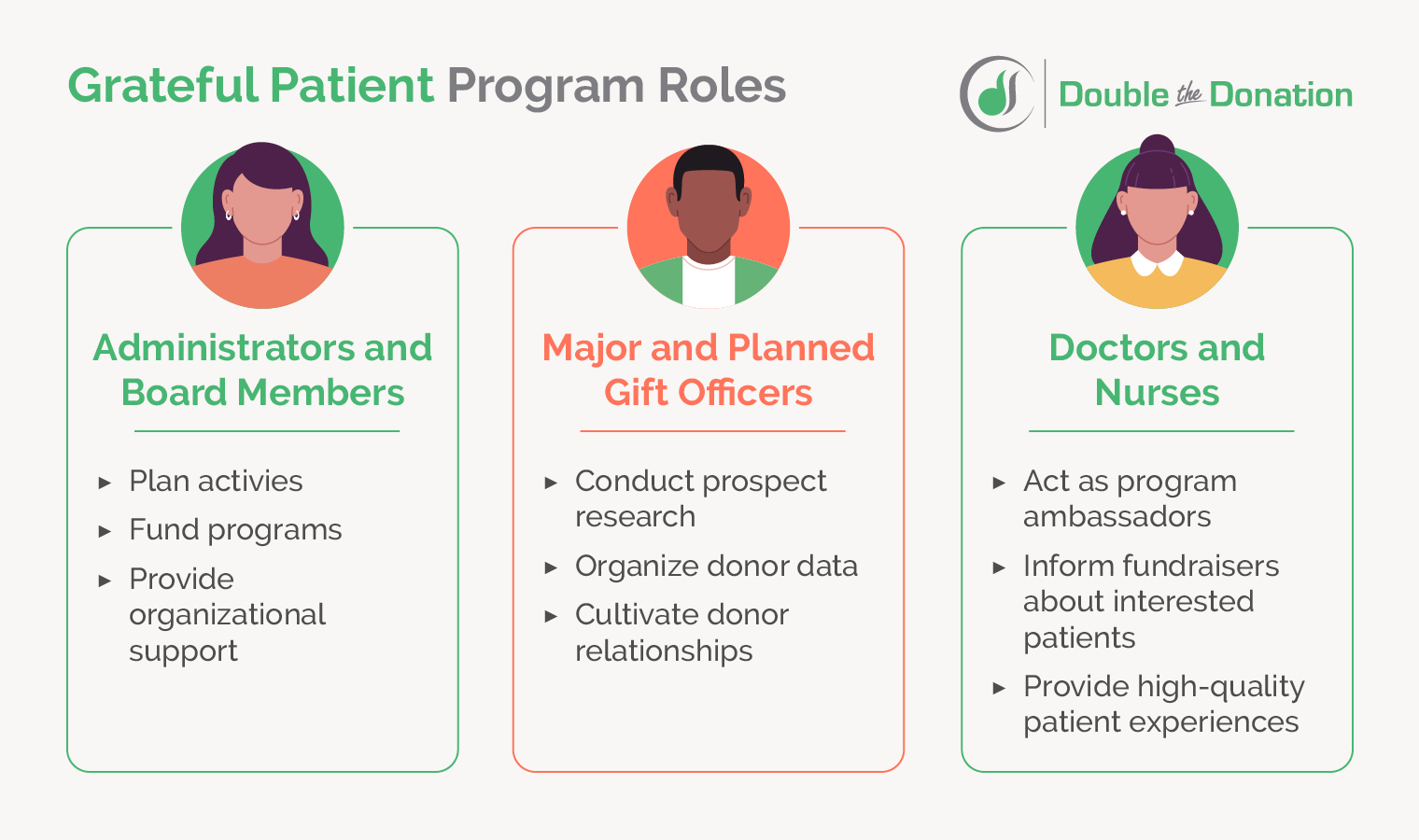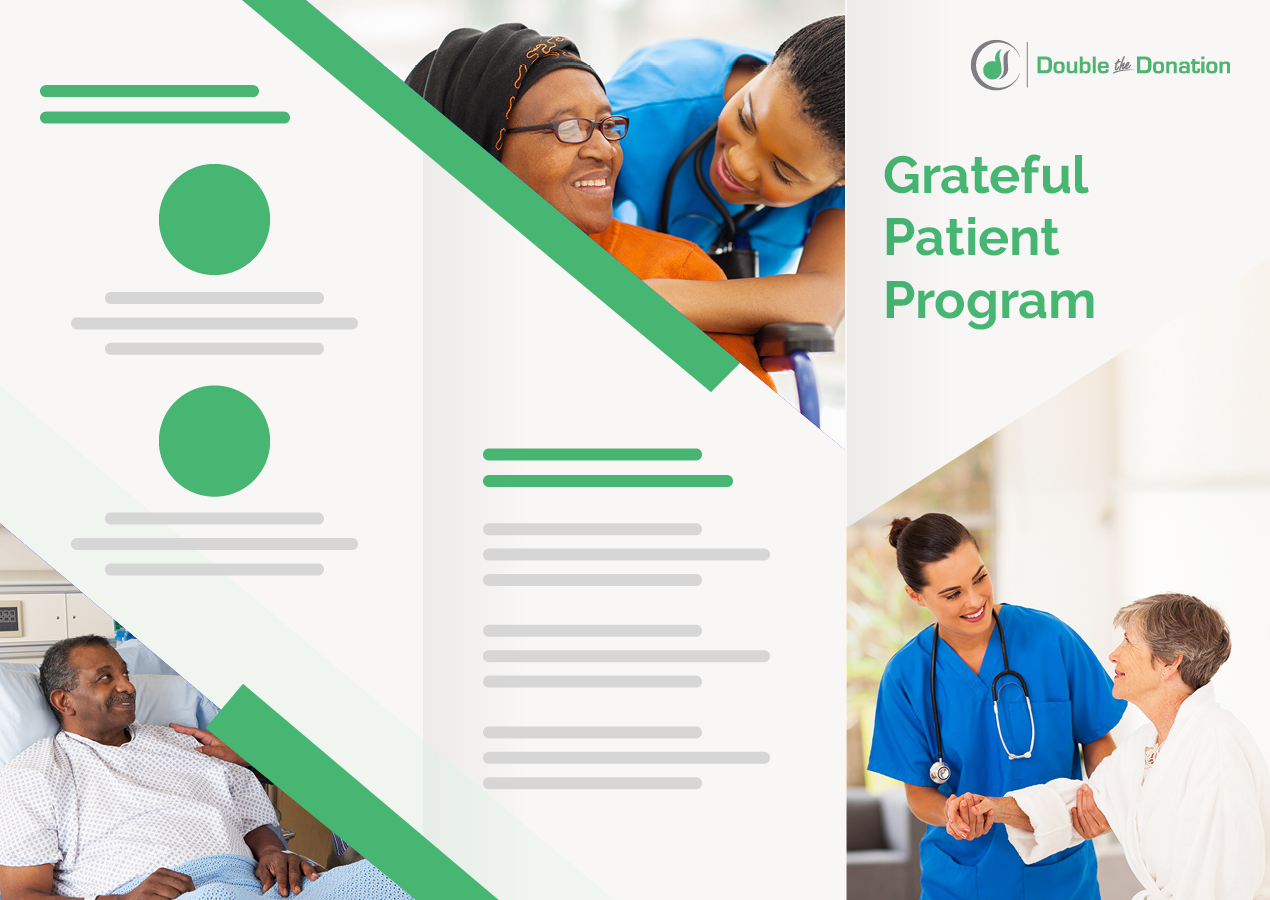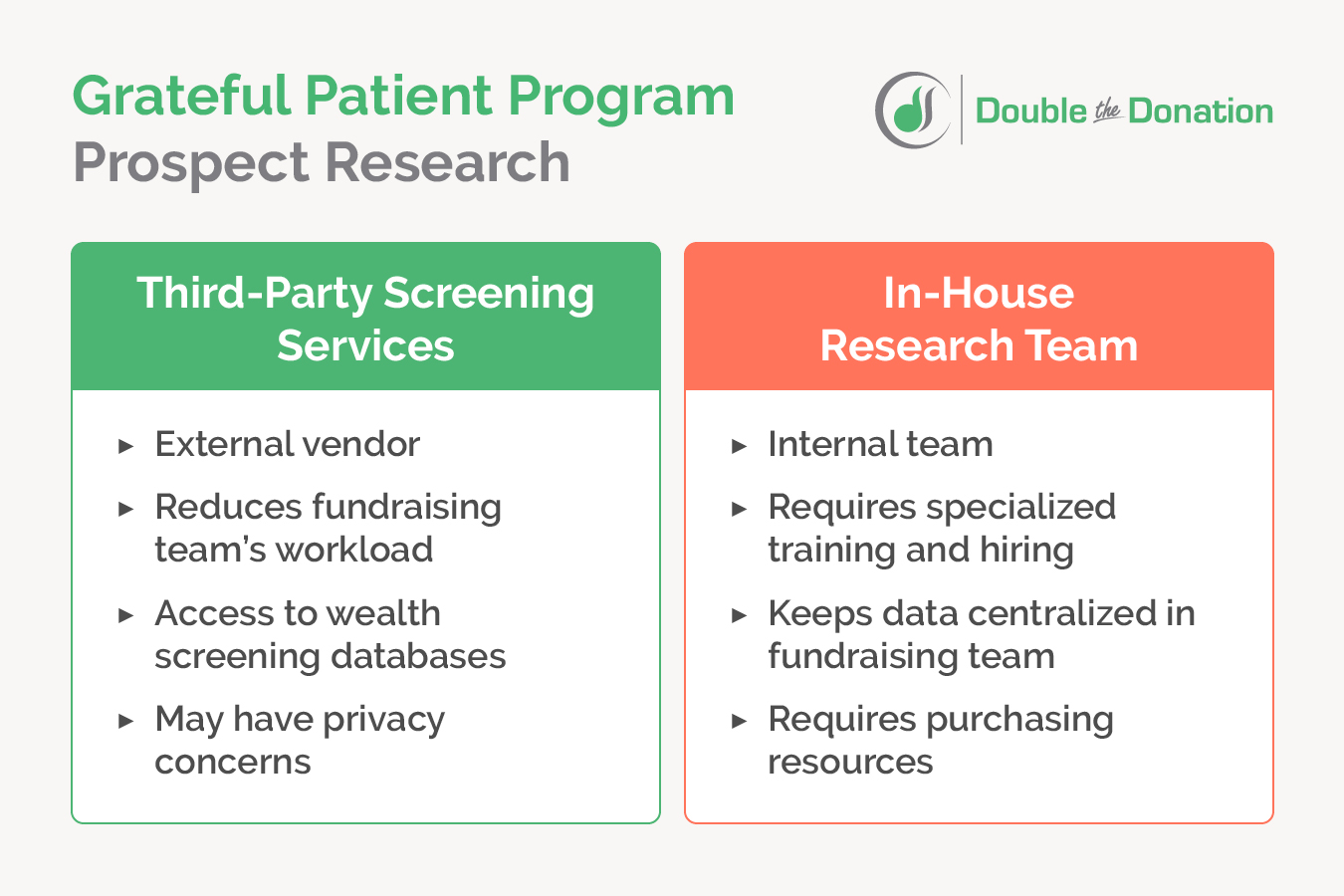7 Key Steps for Championing Your Grateful Patient Program
One of the most rewarding perks of working at a healthcare facility is the meaningful relationships your staff members form with patients. In return for the help and life-changing treatment they received, it’s only natural for patients to seek an outlet for expressing their thanks.
That’s where grateful patient programs come in! This top healthcare fundraising strategy allows patients and their families to honor your hospital’s staff, an area of care, or a clinical program with a generous donation.
Through grateful patient programs, donors can make tangible contributions that directly impact the quality of your patient care, such as by giving funds for a cancer research program, a new MRI machine, or even resources to build a new wing.
That’s why we’ve got your back by outlining seven essential steps for supercharging your grateful patient program.
But before walking through how to connect and earn these vital donations, let’s begin by answering a few basic questions about grateful patient programs.
Grateful Patient Programs: FAQ
Grateful patient programs have a lot in common with other types of fundraising initiatives. However, due to the delicate nature of patient relationships, there are a few key differences that healthcare organizations should be aware of when launching their program.
What is a grateful patient program?
Nonprofit consultant Graham-Pelton offers this definition of grateful patient programs as a starting point: “A grateful patient program consists of all the steps and resources that a healthcare institution uses in order to consistently secure grateful patient donations as an ongoing initiative.”
Essentially, a grateful patient program is a donation program offered by hospitals and healthcare organizations. While these organizations are unlikely to turn down small or mid-sized donations from patients, grateful patient programs usually target individuals who have the potential to be major donors. As such, these programs consist largely of strategies for stewarding relationships with patients.
What are the benefits of a grateful patient program?
Grateful patient programs enable patients to express their gratitude to the hospitals and healthcare organizations that helped them. These donations usually go to programs and services dedicated to treating patients with similar conditions to what they experienced.
For hospitals and other healthcare institutions, grateful patient programs are often a core part of their fundraising strategy. These programs enable hospitals to fund the life-saving services they offer, such as buying new equipment, furthering research, and keeping their staff employed.
What are the elements of a successful grateful patient program?
As we go through how to launch your grateful patient program, we’ll review why each step is essential to your hospital’s success. However, a few core elements of functioning grateful patient programs to highlight beforehand include:
- Supportive staff. Ensure your entire team is aware of and supports your grateful patient program. Create lines of communication between doctors and other medical staff with your fundraising team. When your staff sees your grateful patient program as necessary for your hospital’s continued operations and ability to provide a high level of care, they’ll be more likely to proactively assist fundraisers.
- A positive patient experience. Patients are far more likely to participate in a grateful patient program if they are, in fact, grateful for the care they received. Speak with patients about their experiences at your hospital to ensure they receive high-quality treatment, compassion from your staff, and convenience in accessing care.
- Purposeful results tracking. As with any fundraiser, monitor your results to identify your current strategies’ strengths and weaknesses. Ensure your team tracks metrics such as donor acquisition, repeat donations, response rates to donation solicitations, and patient feedback in response to fundraising requests.
Additionally, your grateful patient program must follow all privacy and compliance regulations. Keep patient data secure and follow HIPAA requirements to show respect for patients, protect their privacy, and avoid compromising your hospital’s standing with state and federal standards.
1. Gain Support for Your Grateful Patient Program
While we hope you’re as enthusiastic about grateful patient programs as we are, remember that not everyone on your hospital staff will be ready to support your program right off the bat. Many members of your team may not be aware of or even have doubts about grateful patient programs, and your first step is to get influential members of your hospital’s leadership on board.
With the support of your hospital administration, board members, and CEO, your healthcare fundraising team can form a dedicated group to plan, manage, and promote a successful grateful patient program.
Here is an overview of the roles various team members might play:
- Hospital administration and board members can lend support for advancing healthcare fundraising initiatives associated with your grateful patient program. These individuals can help plan activities and allocate funding to get your program off the ground.
- Major and planned gift officers will conduct prospect research, organize donor data, and cultivate lasting donor healthcare bonds. Ensure your gift officers coordinate with the rest of your fundraising team to help strategically plan events, adjust outreach, and secure major donations.
- Doctors and nurses can act as ambassadors for your grateful patient program once you’ve gained support from higher-up authorities. Be conscious that medical personnel may be uncomfortable with directly soliciting gifts from patients or families. To help ease the burden, encourage your physicians to only provide information about your grateful patient program to those who express a specific interest in giving back to your hospital. Keep lines of communication open so staff can quickly call in a member of your fundraising team to answer patients’ questions and ensure medical team members can focus on providing care.
To gain buy-in from these teams, do your research and be ready to present data that demonstrates the impact your grateful patient program has the potential to make.
Additionally, the clearer you can be about the specific role each team member will play, the better. After all, doctors are far more likely to support a program if they understand that their main role is to alert your fundraising team to interested patients rather than having to make a sales pitch to their patients themselves.
2. Create Grateful Patient Protocol for Your Hospital
As mentioned, you may have trouble attaining some staff members’ buy-in for your grateful patient program. Often, medical personnel’s concerns stem from worries about how fundraising may impact patient treatment. When will fundraisers approach patients? Will patients feel pressured to donate? Are doctors expected to share patient medical information with your fundraising team?
Approach these concerns seriously, and enforce guidelines that resolve delicate issues associated with your fundraising program to set hospital staff and fundraisers’ minds at ease.
Specifically, to ensure your grateful patient program has a smooth implementation, your fundraising team must address potential challenges early by establishing policies that reflect:
- Compliance with HIPAA guidelines and dedication to protecting patient privacy (see section 5)
- A set of protocols to establish when and how major gift officers or other fundraisers may approach a patient
- A set of protocols to establish when and how physicians and staff can advocate for the grateful patient program
- A clear, open line of communication for physicians and staff to address concerns
By acknowledging these factors in your grateful patient program, you can foster an environment where hospital staff and fundraisers treat contributors as patients first and donors second. If you have doubts about the right way to approach one of these topics, meet with board members, doctors, and other relevant parties to gather first-hand insights and ensure they are part of the decision-making process.
3. Provide Access to Grateful Patient Materials
In an ideal situation, a patient will express their desire to give back to your hospital without prompting. In reality, many patients may want to give back somehow but never vocalize their gratitude to the right people.
To draw attention to your giving initiatives, your healthcare fundraising team should create grateful patient materials easily accessible in the form of easy-to-grab materials, like brochures or pamphlets, to be placed in the hospital.
Doctors and nurses should be aware of where these materials are so they can provide them to patients as needed. Medical staff may feel discomfort talking to patients about fundraising, and educational materials serve as an easy way to continue the conversation without turning your doctors and nurses into fundraisers.
To make the giving process easier, your hospital should also look into creating a page on your website about your grateful patient program. Incorporate online donation tools for patients to make contributions. These virtual giving tools can provide donors with a fast and convenient way to support your grateful patient program with capabilities like:
- Recurring giving options
- Automatic donation receipts
- A matching gift search tool
- Integrated merchandise sales for fundraising events
When investing in new fundraising technology, check whether online giving tools already integrate with your existing nonprofit CRM or fundraising software. Software that integrates with your current system will be easy to implement, prevent data silos, and create less work for your team.
4. Screen Prospects for Your Grateful Patient Program
It’s no secret that hospitals that target donors with high giving potential are more likely to see a return on their investment. After all, while every donation helps, a grateful patient program only pays for itself when it brings in major gifts.
That’s why it’s imperative for your healthcare organization to leverage prospect research resources. Prospect research involves analyzing potential donors’ finances and charitable tendencies to determine their capacity and affinity for making a major gift.
Your fundraising team only has so many major gift officers, and screening patients allows hospitals to allocate their resources by identifying constituents who have the affinity and the ability to give a significant donation.
Typically, hospitals use the following two strategies to conduct prospect research for their grateful patient programs:
- Prospect screening services. Partner with a wealth screening service to gather data about patients’ past donations, real estate purchases, political donations, and other markers of wealth. External partners reduce your team’s workload and may have access to databases your hospital does not. However, sharing patient data with third parties may cause privacy concerns.
- In-house research team. Additionally, your organization can form an in-house research team. These professionals are enlisted by your hospital for the sole purpose of performing prospect research screenings. To set up this team, you will need to hire and train staff to conduct research and purchase access to necessary information databases.
Once your hospital’s fundraising team has identified key prospects, craft targeted communications to pique their interest in your grateful patient program.
5. Emphasize Patient Well-Being in Your Grateful Patient Program
Hospitals can be stressful places, even for patients who receive the best possible care and leave with great results. Without question, your medical institution’s highest priority should be treating patients and ensuring they have as positive an experience at your hospital as possible.
Grateful patient programs rely on positive patient relationships to succeed. Treating patients to the best of your ability is not just the right thing to do—it also helps your hospital secure future funding.
To create an environment where patients feel safe, respected, and valued, in your grateful patient communications, your healthcare facility should always:
- Respect patient privacy. Patients’ medical concerns are between them and their doctors. When reaching out to patients for donations, fundraisers shouldn’t discuss their health, treatment plan, or ongoing medical concerns.
- Align donation opportunities with expressed interests. Covering health-related expenses can be stressful for many people. Ensure you only extend donation requests to patients who have an interest in giving.
- Seek organic opportunities to reach out to prospects. Look for moments when donors are likely to feel generous. For example, if a physician is being recognized for an achievement at your hospital, the physician’s former patients are prime prospects for making a contribution in the physician’s honor.
- Creating a strict solicitation timeline. Follow-up materials should only be sent after a patient has been discharged. Determine how long after a visit to send materials about your grateful patient program. For instance, if recovery from a procedure takes two weeks, you might solicit the patient three weeks after their stay to ensure everything with their treatment is wrapped up.
Use your CRM to track patient data related to fundraising, allowing you to personalize your outreach and connect donors with giving opportunities they are likely to be interested in.
That being said, the best way to honor patient well-being during healthcare fundraising is to adhere to The Health Insurance Portability and Accountability Act (HIPAA). A legal measure, HIPAA guarantees patient protection for confidential medical information against use in a hospital’s healthcare fundraising or promotions.
As such, respect patients’ privacy by not discussing the following HIPAA-defended items with donors’ medical teams:
- Diagnosis
- Nature of service
- Medical treatment
Additionally, have a plan in place for when a patient withdraws their permission to use their medical records in a previous agreement with your hospital. These patients are unlikely to have a high affinity for giving and should not be contacted for further donation solicitations unless they have specifically noted otherwise.
6. Open the Door to Healthcare Fundraising Matching Gifts
Implementing a stellar grateful patient program is an accomplishment, but there is another way for your hospital to maximize those funds: adding matching gifts to your healthcare facility’s fundraising strategy.
Matching gifts allow your grateful patients to use their employer’s matching gift program to double their contribution to your hospital! For instance, if a patient donates $2,000 to your organization, they may just need to fill out an application with their place of work to have their employer donate an additional $2,000, earning your hospital a total of $4,000 from one donor.
Your medical institution can easily set up and promote this donation goldmine. All it takes is for you to incorporate a matching gift search tool into your grateful patient donation process.
Include a matching gift database search tool on your grateful patient online donation form. That way, patients can check their matching gift eligibility while making a donation. Some patients may even have employers who enable matching gift auto-submission.
Auto-submission is the latest technology in matching gifts and allows employees to have their matching gift applications completed for them. Here is a breakdown of how this technology helps donors:
To get started with matching gift auto-submission, your hospital or healthcare-related organization just needs to invest in matching gift software. Donors who qualify for auto-submission can then opt into the process to have their match applications filled out for them, while other match-eligible donors will be prompted to take the next steps to participate in their employer’s corporate matching program.
7. Track Your Grateful Patient Program’s Progress
Last but not least, the success of your grateful patient program relies on how you monitor its progress. With careful and continuous tracking, you can identify places of improvement to tweak to improve your program and better serve your hospital and its patients.
Medical institutions should establish clear goals and criteria for how their grateful patient program should develop based on metrics like:
- ROI
- Number of donors
- Response rate
- Retention rate
- Average gift size
While big-picture results determine whether your program is a success, you can make targeted improvements by tracking more granular data. As part of your program, have your fundraising team take note of:
- How long it takes to convert a prospect to a grateful patient donor. Roughly how many conversations does a major gift officer need to have with a patient before they make a donation? How long should you wait after a patient’s discharge to reach out with fundraising requests? Do any patients contact your team to inquire about donations, or does your team start the majority of donation conversations?
- The response rate to different grateful patient communication strategies. Whenever you implement a new strategy for reaching out to patients, document your approach and patient response rates. You may be able to attain data directly by surveying long-term donors about their thoughts on different strategies, but much of your data will be observational, such as noticing if response rates change or become increasingly positive or negative.
- The response quality to different grateful patient stewardship techniques. Once patients have expressed interest in your grateful patient program, they have entered the stewardship phase of your engagement. Have major gift officers document their meetings with prospective supporters in their donor profiles. Then, use this information to determine both individuals’ and your donors’ response as a whole to various relationship-building strategies.
To maintain a better grip on these factors, use a robust nonprofit CRM software solution. This technology will save your healthcare fundraising team a lot of stress while managing your grateful patient program’s growth.
More Resources for Grateful Patient Programs
The bond between patients and healthcare staff is like no other; it requires hard work, respect, and communication to ease patients’ discomfort and make them feel safe and cared for during their time at your hospital. Encourage your patients to help others receive the same exceptional care they did by making a personal donation to your grateful patient program.
For more must-know tips on how to boost your healthcare fundraising, check out these additional resources:
- 5 Healthcare Fundraising Strategies to Skyrocket Donations. Elevate your healthcare fundraising with our master strategies for medical facilities of all shapes and sizes.
- Donor Management Software: Our Top 15+ Picks. Find a CRM that can facilitate your fundraising program by managing donor communication and information. Explore our top picks to jumpstart your software research.
- Become an Expert: Access The Ultimate Guide to Matching Gifts. Interested in helping patients make the most of matching gifts? Download our matching gift guide to learn how to promote your new matching gift program and tap into corporate giving.








